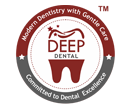Wisdom teeth, also known as third molars, are the last teeth to erupt in your mouth. This is generally occurs between the ages of 17 and 25, a time of life that has been called the “Age of Wisdom.”Anthropologists note that the rough diet of early humans resulted in the excessive wear of their teeth.Normal drifting of the teeth to compensate for this wear ensured that space was available for most wisdom teeth to erupt by adolescence. The modern diet, which is much softer, and the popularity of orthodontic tooth straightening procedures produce a fuller dental arch, which quite commonly doesn’t leave room for the wisdom teeth to erupt, thereby setting the stage for problems when the final molars enter the mouth.
What is an impacted tooth?
A tooth becomes impacted when there is a lack of space in the dental arch and its growth and eruption are prevented by overlying gum, bone or another tooth
How serious is an impacted tooth?
Impacted teeth can be painful and lead to infection. They may also crowd or damage adjacent teeth or roots.
More serious problems may occur if the sac surrounding the impacted tooth becomes filled with fluid and enlarges to form a cyst. As the cyst grows it may hollow out the jaw and permanently damage adjacent teeth, the surrounding bone and nerves. Rarely, if a cyst is not treated, a tumor may develop from its walls and a more serious surgical procedure may be required to remove it.
Must the tooth be removed if it hasn’t caused any problems yet?
Not all problems related related to third molars are painful or visible. Damage can occur without your being aware of it.
As wisdom teeth grow, their roots become longer, the teeth become more difficult to remove and complications become more likely. In addition, impacted wisdom teeth are more likely to cause problems as patients age.
No one can predict when third molar complications will occur, but when they do, the circumstances can be much more painful and the teeth more difficult to treat. It is estimated that about 85% of third molars will eventually need to be removed.
What happens during surgery?
Before surgery, your oral surgeon will discuss with you what to expect. This is a good time to ask questions or express your concerns. It is especially important to let the dentist know about any illness you have and medications you are taking.
The relative ease with which a wisdom tooth may be removed depends on several conditions, including the position of the tooth and root development. Impacted wisdom teeth may require a more involved surgical procedure.
Most wisdom tooth extractions are performed under local anesthesia and sometimes under general anesthesia. Your oral surgeon will discuss the anesthetic option that is right for you.
What happens after surgery?
Following surgery, you may experience some swelling and mild discomfort, which are part of the normal healing process. Cold compresses may help decrease the swelling, and medication prescribed by your Oral Surgeon can help manage the discomfort. You may be instructed to modify your diet following surgery and later progress to more normal foods.
Post Extraction Instructions
Anesthetics
The length and the time you experience numbness varies, depending on the amount and the type of the anesthetic used. While your mouth is numb, you’ll want to be careful not to bite your lip, cheek or tongue. For this reason, it is important that you do not have any foods that require chewing while your mouth is still numb. If you have liquids it is important to not use a straw as the pressure created my dislodge the clot and cause fresh bleeding. The numbness should subside in a few hours.
Bleeding
Your dentist may place a gauze pack on the site to limit the bleeding and confine the blood while clotting takes place. This pack should be left in its place for about 30 – 45 minutes after you leave the dentists office. Do not chew on the pack, just hold it gently.
After the pack is removed you may experience some bleeding, if so follow these instructions:
Fold a piece of clean gauze thick enough to bite on. Dampen the gauze with warm water and hold it on the extraction site.
Apply moderate pressure by closing your teeth firmly over the gauze pad. Maintain this pressure for 30 minutes.
Do not suck on the extraction site or disturb it with your tongue.
A slight amount of blood may leak from the wound till the clot forms. Do not panic. However if it is heavy bleeding contact your dentist.
Here is how you can take care of the clot that will help heal your wound faster
- Do not smoke, consume alcohol, drink with a straw or rinse vigorously for the next 24 hrs.
- Avoid mouth wash or aerated drinks or alcohol.
- Do not clean next to the bleeding socket for the rest of the day. However floss and rish other teeth thoroughly.
- Limit strenuous activity for tge next 24 hrs.
Medication
If your dentist has prescribed medicines to control infection and pain, use them as directed. Call the dentist if the pain is not controlled, do not self medicate.
Swelling and pain
You can help reduce swelling that may occur after extraction by applying a cold ice pack on your face for about 30 min in regular intervals. If your pain and swelling does not reduce over a prolonged period or you suffer from nausea, severe pain, bleeding or fever, contact your dentist immediately.
Diet
Eat healthy but soft nutritious diet, drink plenty of fluids and keep your self fit. Try chewing from the opposite side. Start solid food consumption slowly and when you feel comfortable.
Follow up
Make sure you follow up after your extraction, when instructed, even if you feel fine.

